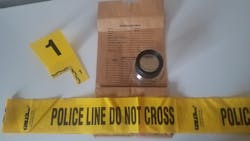Blood spatter fascinates most and the majority of people will tell you blood spatter is their favorite forensic discipline. But what about the absence of blood? Is that as significant as the presence of it ?
Yes, in fact sometimes the absence of blood is more telling than the blood spatter itself. Don’t get me wrong, blood spatter is very helpful in investigation and once you understand how to read it, it brings to light so much of the story of what happened at that scene. The absence of blood is just as remarkable.
For example, if you have a scene where a significant amount of blood is present, such as a large blood pool, but there is an area in the middle of that pool with no blood, chances are something was there and was moved. This could indicate tampering with evidence or could tell more about the incidents that took place.
A large void present in blood spatter can also indicate the location where a suspect was standing. Say you have high velocity blood spatter on the wall that is consistent yet you have a space in the wall where there is no blood. (an interruption) This is a prime example of a possible blood void where an individual could have been standing. These clues can play a huge role in relating the necessary information needed to put all of the pieces of the puzzle together.
Do you document blood voids? Absolutely! If you are processing a crime scene and have any type of void, mark it with an evidence marker, photograph it and swab it just as you would any other piece of evidence. (and I suggest you swab it in case there are any other types of trace substances present in the void)
You never know what clues may end up being the most significant in a case-never let a blood void go undocumented.
About the Author

Hilary Rodela
Hilary Rodela is currently a Surveillance Officer, a former Private Investigator, a former Crime Scene Investigator, and Evidence Technician. She worked for the Ruidoso (NM) Police Department as well as the Lubbock (TX) Police Department. She has written for several public safety publications and has extensive law enforcement and forensic training and is pursuing forensic expertise in various disciplines. Hilary is a freelance public safety writer and curriculum developer for the National Investigative Training Academy.
